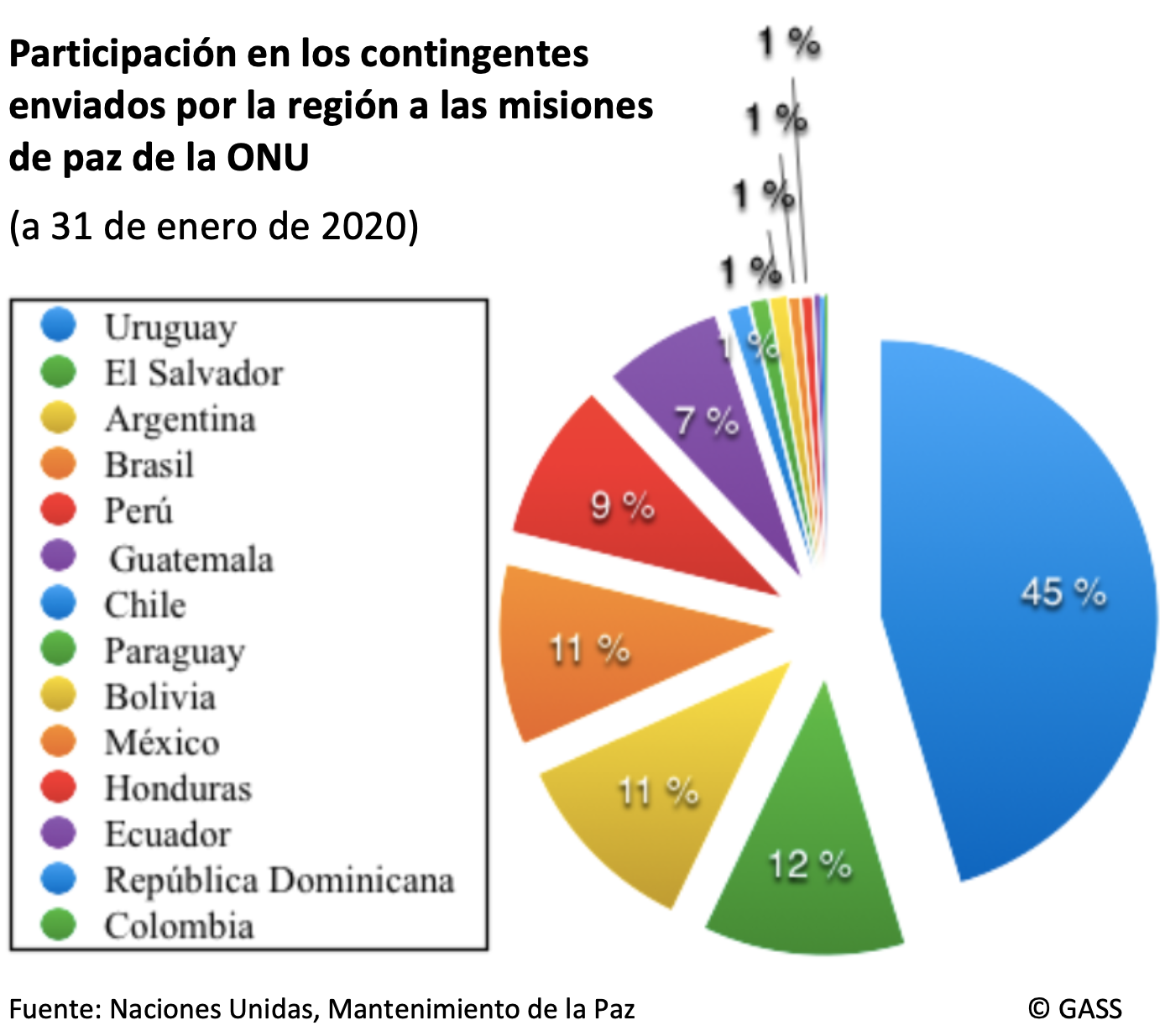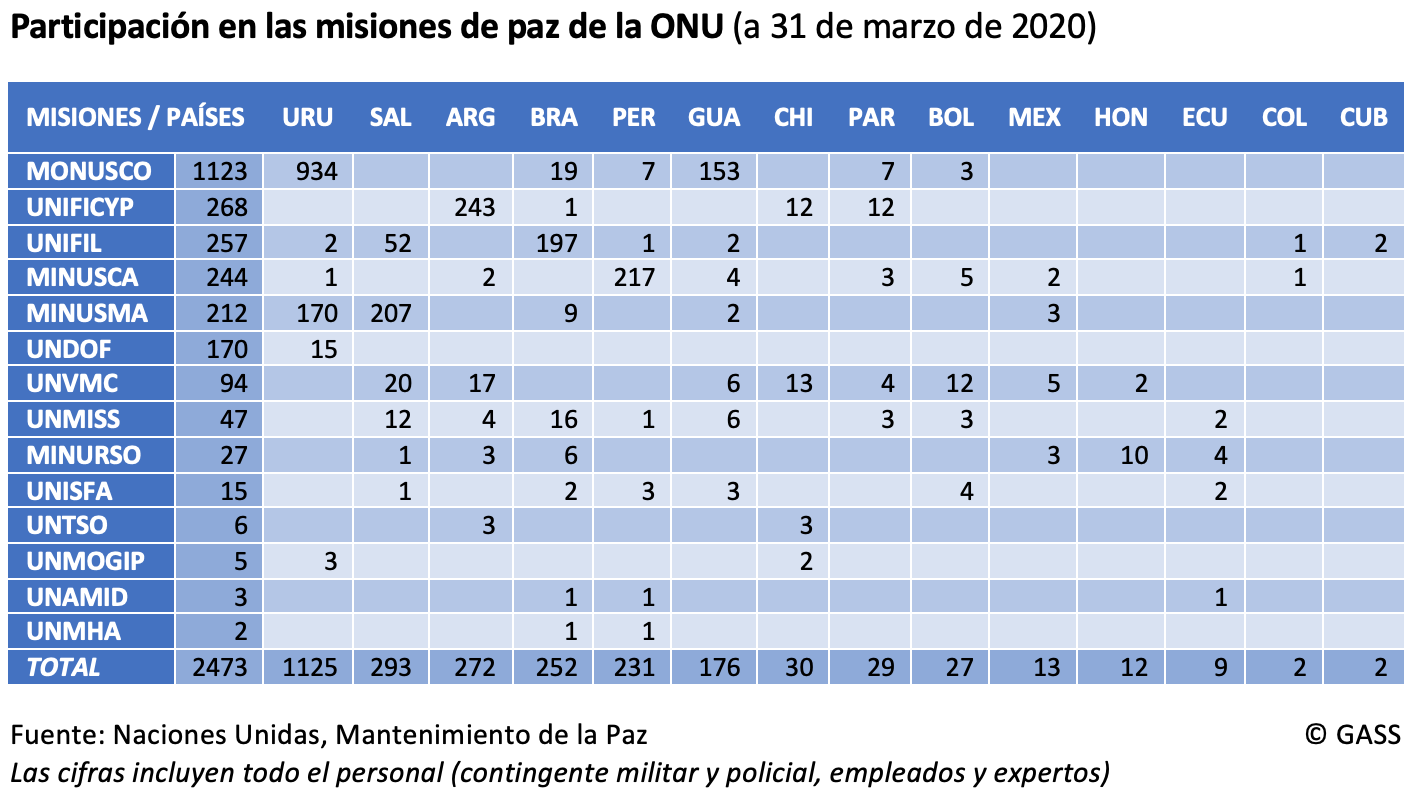Uruguay contributes 45.5% of the Latin American workforce and El Salvador is second with 12%, both ahead of the regional powers.
-
Of the total 82,480 troops in the fourteen UN peacekeeping missions at the beginning of 2020, 2,473 came from Latin American countries, most of them military and police.
-
Nearly all troops from the region serve in missions in Africa; 45.4% serve in the DRC stabilization plan.
-
After Uruguay and then El Salvador come Argentina, Brazil, Peru and Guatemala; Mexico, on the other hand, is one of the lowest contributors (only 13 experts and employees, not troops).
![Bolivian soldier in training exercises for UN peacekeeping missions, 2002 [Wikipedia]. Bolivian soldier in training exercises for UN peacekeeping missions, 2002 [Wikipedia].](/documents/10174/16849987/cascos-azules-blog.jpg)
▲ Bolivian soldier in training exercises for UN peacekeeping missions, 2002 [Wikipedia].
report SRA 2020 / Jaime Azpiri[PDF version].
MAY 2020-Latin America's contribution to international peacekeeping missions sponsored by the United Nations is below the weight of its population and Economics in the world (around 8% and 7%, respectively). Of the total of 82,480 people participating in the various UN missions as of January 31, 2020, only 2,473 were from Latin American countries, representing 2.9% of the total. A similar percentage (3%) was recorded when considering only the military or police staff of the missions (about 2,150 uniformed personnel, out of a total of 70,738; the rest corresponded to employees and experts).
This is a smaller external presence than might be expected, given the insistence of many countries in the region on multilateralism and the desirability of strong international institutions to limit the expansionary impulses of the great powers. A special exception is Uruguay, precisely the most coherent nation in its defense of international arbitration, which, despite its small population, is by far the largest contributor of staff to peacekeeping missions. Its 1,125 envoys make up 45.5% of the total Latin American contingent.
While Uruguay's strong contribution is not surprising, it is surprising that the second country with the highest participation is El Salvador, with 293 people (12% of Latin America's contribution). This is followed by two very important countries, Argentina and Brazil, (272 and 252 envoys, respectively); then Peru (231) and Guatemala (176). On the other hand, Mexico, despite all its economic and human potential, is particularly absent from these international missions (only 13 people, moreover as employees or experts, not troops), both due to constitutional restrictions and political doctrine. In the case of Colombia (only 2 experts), this may be due to the need to devote its military force entirely to the pacification of the country itself, although one would expect greater capacity and availability from a NATO global partner , the only designation in Latin America that it achieved in 2018.
The most attended international assignment, which brings together 45.4% of the total contingent in the region, is that of the UN mission statement for the stabilization of the Democratic Republic of the Congo, from whose name in French comes the acronym MONUSCO. It involves 1,123 Latin Americans, the majority of whom are Uruguayan envoys (934), with the greatest participation also of Guatemalans on military missions abroad (153).

Previous outstanding missions
Although Latin American countries generally do not participate much in military missions abroad, the sending of troops abroad is not alien to the history of the American republics after their independence. A first intervention was the so-called "ABC", a coalition formed by Argentina, Brazil and Chile in the context of the Mexican Revolution, at the beginning of the last century, to prevent civil war in the North American country. Another conflict that required mediation was the Chaco War in the 1930s. In this confrontation between Paraguay and Bolivia, the interventions of Chile and Argentina were crucial to subsequently define the reaffirmation of the nationality of the Chaco region.
At the end of the 20th century, the most important mission statement was the one aimed at pacifying the former Yugoslav republics, called UNPROFOR by the UN. Argentina was the Latin American country with the largest presence of troops in that scenario. Shortly afterwards, in the 1990s, two international missions were implemented, this time in the Western Hemisphere itself, to secure the agreements that put an end to the civil wars in El Salvador (ONUSAL) and Guatemala (MINUGUA). At the end of that decade, the MOMEP was articulated to impose an armistice between Peru and Ecuador, which were at war in the Cenepa War.
Also in Colombia, some leaders at some point considered the possibility of apply for the presence of blue helmets in order to control and, in the long term, put an end to the FARC insurrection. Later Colombian President Álvaro Uribe proposed in 1998 the presence of international troops in the face of the inability of the government of the time to control the situation, but the initiative was not carried out. After the peace agreement in 2016, the signatory parties asked the UN for a mission statement to monitor compliance with the terms of the agreement, known as UNVMC, which operates with a maximum of 120 people (some civilians and a hundred military and police), of which, in January 2020, 94 came from Latin American countries.

The contrast between Uruguay and Mexico
Today, the countries of the region are present in 14 different peace missions (out of the total of 21 promoted by the UN), especially in Africa but also in other parts of the world. In MINUSCA, convened for the pacification of the Central American Republic, 9 Latin American nations participate, the same issue as in UNVMC, the mission statement of verification of the peace agreements in Colombia. In UNMISS, mission statement of attendance in South Sudan, 8 countries participate and in MONUSCO, implemented in the Democratic Republic of Congo, 7 do so.
As mentioned above, Uruguay is the largest contributor to the missions underway (1,126 personnel, as of January 31). This staff is basically assigned to MONUSCO (934) and to a lesser extent to UNDOF (170), which ensures security in the Golan Heights as a separation force between Syrians and Israelis; in total, Uruguayan blue helmets are present in 6 different missions. This service has been especially recognized by the United Nations, which values Uruguay's long trajectory in this subject: for example, it highlighted its attendance in the mission statement carried out in Haiti after the disaster caused by hurricane Dean, to which it assigned 13,000 troops between 2007 and 2014. The contribution of Uruguay, a country of only 3.5 million inhabitants, is greater than that of Spain (648), France (732) or Italy (1084).
On the other hand, the case of Mexico is the most striking because of its very limited participation in peacekeeping missions, considering that it is one of the powers in the region. The North American country is the second Latin American nation that uses the most resources for the development its Armed Forces, with a total of 7 million dollars, placing it, by far, behind the first place that corresponds to Brazil, with a total of almost 29.5 million dollars. Historically, Mexico has participated in more than 80 peacekeeping missions, providing troops from the Federal Police and the Army, generally in low issue. The previous president, Enrique Peña Nieto, announced in 2014 that Mexican units would once again participate decisively in armed operations in support of the UN, however today their contribution is reduced to 13 people (9 experts and 4 employees), which represents only 1% of Latin American participation. The most relevant reason to explain the Mexican phenomenon is the long tradition in favor of the Estrada doctrine of non-intervention in the internal affairs of other countries. In addition, the Mexican Constitution restricts the deployment of troops abroad unless Mexico has declared war on an enemy.